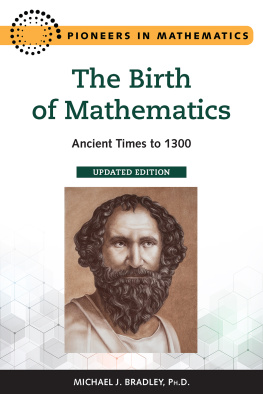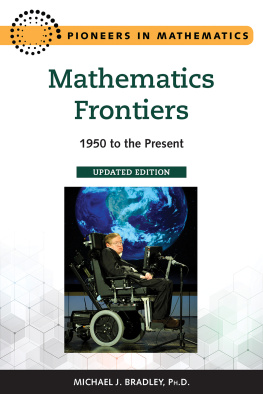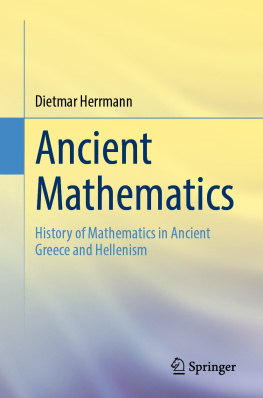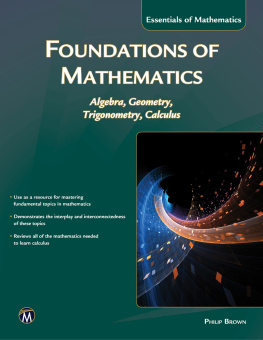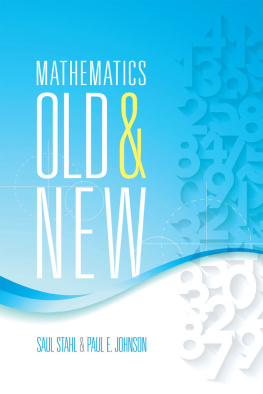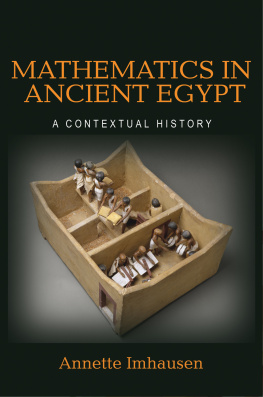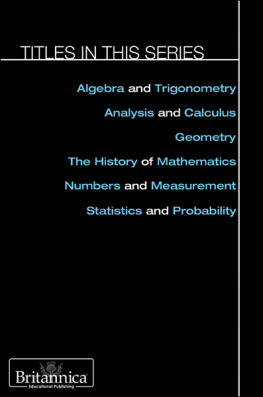The Birth of Mathematics, Updated Edition
Copyright 2019 by Michael J. Bradley
All rights reserved. No part of this publication may be reproduced or utilized in any form or by any means, electronic or mechanical, including photocopying, recording, or by any information storage or retrieval systems, without permission in writing from the publisher. For more information, contact:
Chelsea House
An imprint of Infobase
132 West 31st Street
New York NY 10001
ISBN 978-1-4381-8226-1
You can find Chelsea House on the World Wide Web
at http://www.infobase.com
Preface
Mathematics is a human endeavor. Behind its numbers, equations, formulas, and theorems are the stories of the people who expanded the frontiers of humanity's mathematical knowledge. Some were child prodigies while others developed their aptitudes for mathematics later in life. They were rich and poor, male and female, well educated and self-taught. They worked as professors, clerks, farmers, engineers, astronomers, nurses, and philosophers. The diversity of their backgrounds testifies that mathematical talent is independent of nationality, ethnicity, religion, class, gender, or disability.
Pioneers in Mathematics is a five-volume set that profiles the lives of 50 individuals, each of whom played a role in the development and the advancement of mathematics. The overall profiles do not represent the 50 most notable mathematicians; rather, they are a collection of individuals whose life stories and significant contributions to mathematics will interest and inform middle school and high school students. Collectively, they represent the diverse talents of the millions of people, both anonymous and well known, who developed new techniques, discovered innovative ideas, and extended known mathematical theories while facing challenges and overcoming obstacles.
Each book in the set presents the lives and accomplishments of 10 mathematicians who lived during an historical period. The Birth of Mathematics profiles individuals from ancient Greece, India, Arabia, and medieval Italy who lived from 700 B.C.E. to 1300 C.E.The Age of Genius features mathematicians from Iran, France, England, Germany, Switzerland, and America who lived between the 14th and 18th centuries. The Foundations of Mathematics presents 19th-century mathematicians from various European countries. Modern Mathematics and Mathematics Frontiers profile a variety of international mathematicians who worked in the early 20th and the late 20th century, respectively.
The 50 chapters of Pioneers in Mathematics tell pieces of the story of humankinds attempt to understand the world in terms of numbers, patterns, and equations. Some of the individuals profiled contributed innovative ideas that gave birth to new branches of mathematics. Others solved problems that had puzzled mathematicians for centuries. Some wrote books that influenced the teaching of mathematics for hundreds of years. Still others were among the first of their race, gender, or nationality to achieve recognition for their mathematical accomplishments. Each one was an innovator who broke new ground and enabled their successors to progress even further.
From the introduction of the base-10 number system to the development of logarithms, calculus, and computers, most significant ideas in mathematics developed gradually, with countless individuals making important contributions. Many mathematical ideas developed independently in different civilizations separated by geography and time. Within the same civilization, the name of the scholar who developed a particular innovation often became lost as his idea was incorporated into the writings of a later mathematician. For these reasons, it is not always possible to identify accurately any one individual as the first person to have discovered a particular theorem or to have introduced a certain idea. But then mathematics was not created by one person or for one person; it is a human endeavor.
Introduction
This first volume of the Pioneers in Mathematics set profiles the lives of 10 mathematicians who lived between 700 B.C.E. and 1300 C.E. During these 20 centuries, thousands of scholars from many civilizations introduced mathematical ideas that established the foundations of arithmetic, number theory, algebra, geometry, and trigonometry as well as the related sciences of astronomy and physics. All the great civilizations that flourished during these and earlier centuries developed mathematical innovations. We know very little about the specific individuals who made important discoveries and introduced new ideas in Babylonia, Egypt, and China. Historians in Greece, India, Arabia, and medieval Italy preserved a more complete record of their civilizations' mathematical discoveries and recorded the identities of some of the innovators. For this reason, this book profiles 10 individuals from these four cultures as representatives of the numerous scholars from all the cultures of this era.
During the first half of this 2,000-year period, Greek scholars developed a formalized system of practical and theoretical mathematics. In the seventh century B.C.E., Thales of Miletus helped to provide a logical basis for the discipline of mathematics by producing the earliest-known proofs of geometrical theorems. A century later, Pythagoras of Samos founded a school where he and his followers studied diverse mathematical ideas, including perfect numbers, the lengths of the sides of right triangles, and the five regular solids. In the third century B.C.E., Euclid of Alexandria wrote Elements, the book that defined the study of geometry for 2,000 years. His contemporary, Archimedes of Syracuse used innovative geometrical techniques to estimate perimeters, areas, and volumes, to determine tangent lines, and to trisect angles. In the fourth century C.E., Hypatia of Alexandria, the earliest-known woman to write and teach about higher mathematics, wrote commentaries that enhanced and preserved the works of earlier Greek scholars.
Generations of mathematicians in India also developed advanced ideas and techniques in various branches of mathematics. Two of the foremost Hindu scholars of this period were ryabhata and Brahmagupta. In the sixth century, ryabhata introduced an alphabetical system of notation to represent large numbers and developed techniques for estimating distances, determining areas, and calculating volumes. In the seventh century, Brahmagupta developed rules for performing arithmetic with negative numbers and introduced iterative algorithms to find sines of angles and square roots.
During the next six centuries, Arabic mathematicians further extended the discoveries of Greek and Indian scholars. The ninthcentury mathematician Muhammad al-Khwrizm demonstrated how to solve second-degree equations in the earliest-known text on algebra. In the 11th century, Omar Khayym developed geometrical techniques for solving algebraic equations and expanded on Euclids theory of ratios.
In 13th-century Italy, Leonardo Fibonacci wrote about the base-10 number system and the efficient computational algorithms that Hindu and Arabic scholars had developed. His book was one of several similar works on arithmetic and computation that caused western Europeans to renew their interest in Greek mathematics and convinced them to adopt the Hindu-Arabic numbering system.

